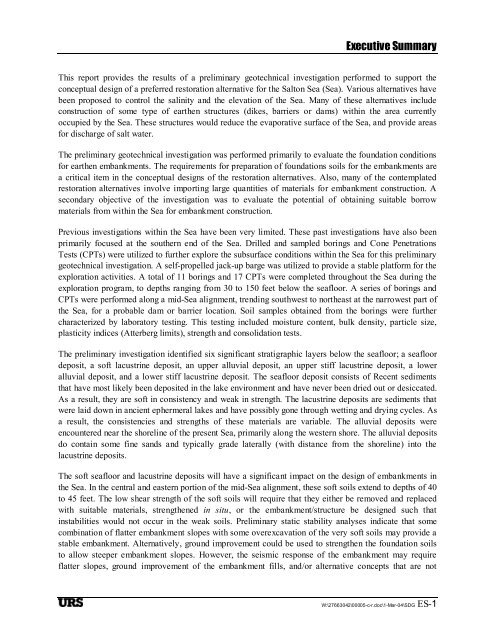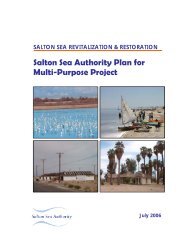Salton Sea Preliminary In-Sea Geotechnical Investigation
Salton Sea Preliminary In-Sea Geotechnical Investigation
Salton Sea Preliminary In-Sea Geotechnical Investigation
You also want an ePaper? Increase the reach of your titles
YUMPU automatically turns print PDFs into web optimized ePapers that Google loves.
Executive SummaryThis report provides the results of a preliminary geotechnical investigation performed to support theconceptual design of a preferred restoration alternative for the <strong>Salton</strong> <strong>Sea</strong> (<strong>Sea</strong>). Various alternatives havebeen proposed to control the salinity and the elevation of the <strong>Sea</strong>. Many of these alternatives includeconstruction of some type of earthen structures (dikes, barriers or dams) within the area currentlyoccupied by the <strong>Sea</strong>. These structures would reduce the evaporative surface of the <strong>Sea</strong>, and provide areasfor discharge of salt water.The preliminary geotechnical investigation was performed primarily to evaluate the foundation conditionsfor earthen embankments. The requirements for preparation of foundations soils for the embankments area critical item in the conceptual designs of the restoration alternatives. Also, many of the contemplatedrestoration alternatives involve importing large quantities of materials for embankment construction. Asecondary objective of the investigation was to evaluate the potential of obtaining suitable borrowmaterials from within the <strong>Sea</strong> for embankment construction.Previous investigations within the <strong>Sea</strong> have been very limited. These past investigations have also beenprimarily focused at the southern end of the <strong>Sea</strong>. Drilled and sampled borings and Cone PenetrationsTests (CPTs) were utilized to further explore the subsurface conditions within the <strong>Sea</strong> for this preliminarygeotechnical investigation. A self-propelled jack-up barge was utilized to provide a stable platform for theexploration activities. A total of 11 borings and 17 CPTs were completed throughout the <strong>Sea</strong> during theexploration program, to depths ranging from 30 to 150 feet below the seafloor. A series of borings andCPTs were performed along a mid-<strong>Sea</strong> alignment, trending southwest to northeast at the narrowest part ofthe <strong>Sea</strong>, for a probable dam or barrier location. Soil samples obtained from the borings were furthercharacterized by laboratory testing. This testing included moisture content, bulk density, particle size,plasticity indices (Atterberg limits), strength and consolidation tests.The preliminary investigation identified six significant stratigraphic layers below the seafloor; a seafloordeposit, a soft lacustrine deposit, an upper alluvial deposit, an upper stiff lacustrine deposit, a loweralluvial deposit, and a lower stiff lacustrine deposit. The seafloor deposit consists of Recent sedimentsthat have most likely been deposited in the lake environment and have never been dried out or desiccated.As a result, they are soft in consistency and weak in strength. The lacustrine deposits are sediments thatwere laid down in ancient ephermeral lakes and have possibly gone through wetting and drying cycles. Asa result, the consistencies and strengths of these materials are variable. The alluvial deposits wereencountered near the shoreline of the present <strong>Sea</strong>, primarily along the western shore. The alluvial depositsdo contain some fine sands and typically grade laterally (with distance from the shoreline) into thelacustrine deposits.The soft seafloor and lacustrine deposits will have a significant impact on the design of embankments inthe <strong>Sea</strong>. <strong>In</strong> the central and eastern portion of the mid-<strong>Sea</strong> alignment, these soft soils extend to depths of 40to 45 feet. The low shear strength of the soft soils will require that they either be removed and replacedwith suitable materials, strengthened in situ, or the embankment/structure be designed such thatinstabilities would not occur in the weak soils. <strong>Preliminary</strong> static stability analyses indicate that somecombination of flatter embankment slopes with some overexcavation of the very soft soils may provide astable embankment. Alternatively, ground improvement could be used to strengthen the foundation soilsto allow steeper embankment slopes. However, the seismic response of the embankment may requireflatter slopes, ground improvement of the embankment fills, and/or alternative concepts that are notW:\27663042\00005-c-r.doc\1-Mar-04\SDG ES-1



